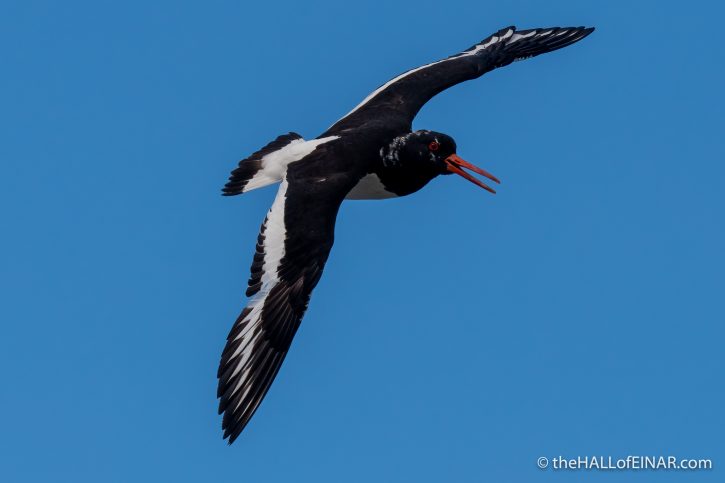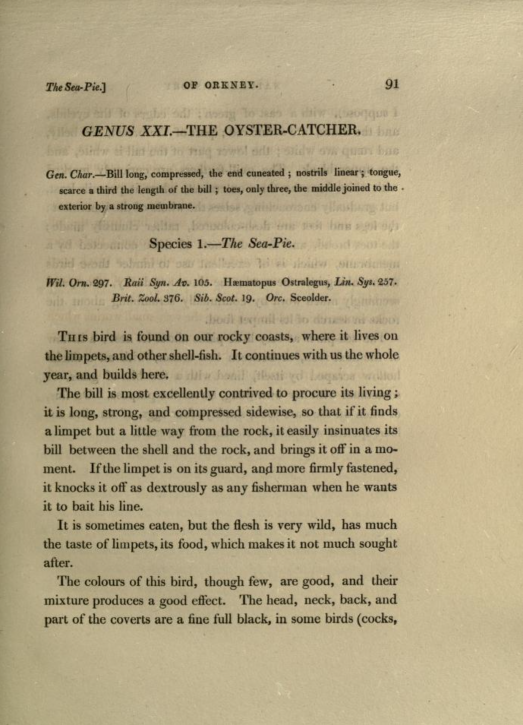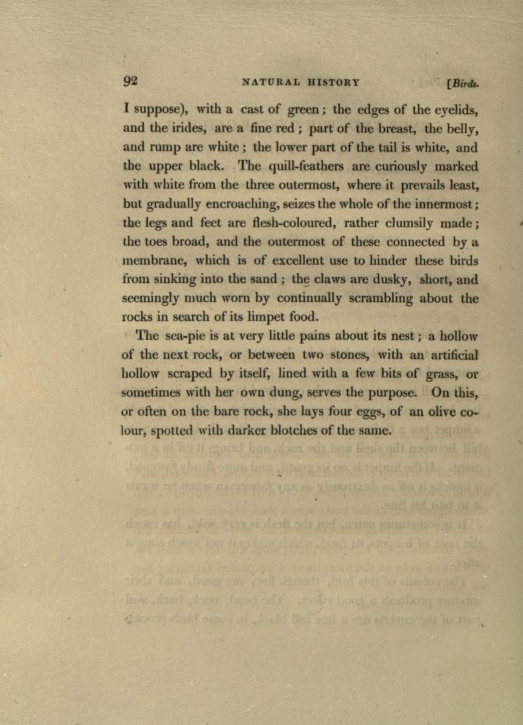Skeldro, Chaldro or Shaalder

There’s a Skeldro, Chaldro or Shaalder, as the Oystercatcher is known in Orkney, in the air. It’s giving me what can only be described as a ‘right telling off’. It’s got that special tone of someone who is really, really irritated and now at the end of their tether. The local Orkney names all seem to mean ‘scolder’. That’s the perfect word to describe their attitude.
I’m going to consider myself scolded.
The Oystercatcher is mentioned in the Fauna Orcadensis from 1813. It’s referred to as the Sea-Pie:


Here’s what the Rev. Low says about the Oystercatcher:
Bill long, compressed, the end cuneated; nostrils linear; tongue, scarce a third the length of the bill; toes, only three, the middle joined to the exterior by a strong membrane.
Cuneated is a new word to me; it means triangular or wedge-shaped. Then he says that their name is the Sea-Pie.
Species 1. – The Sea-Pie.
Hæmatopus ostralegus
Orc. Sceolder.
I also love the spelling of Sceolder.
This bird is found on our rocky coasts, where it lives on the limpets, and other shell-fish. It continues with us the whole year, and builds here.
The bill is most excellently contrived to procure its living: it is long, strong, and compressed sidewise, so that if it finds a limpet but a little way from the rock, it easily insinuates its bill between the shell and the rock, and brings it off in a moment. If the limpet is on its guard, and more firmly fastened, it knocks it off as dextrously as any fisherman when he wants it to bait his line.
I can’t imagine anyone this century saying ‘most excellently contrived’. I think I might start a trend.
It is sometimes eaten, but the flesh is very wild, has much the taste of limpets, its food, which makes it not much sought after.
I wonder how many Oystercatchers had to be eaten before people decided that the flesh was too ‘wild’? Oystercatchers specialise in eating cockles and mussels. Did you complete that sentence by saying ‘Alive, alive-oh’? Well you’re not Molly Malone and we’re not in Dublin now.
The colours of this bird, though few, are good, and their mixture produces a good effect. The head, neck, back, and part of the coverts are a fine full black, in some birds (cocks, I suppose), with a cast of green; the edges of the eyelids, and the irides, are a fine red; part of the breast, the belly, and rump are white; the lower part of the tail is white, and the upper black. The quill-feathers are curiously marked with white from the three outermost, where it prevails least, but gradually encroaching, seizes the whole of the innermost; the legs and feet are flesh-coloured, rather clumsily made; the toes broad, and the outermost of these connected by a membrane, which is of excellent use to hinder these birds from sinking into the sand; the claws are dusky, short, and seemingly much worn by continually scrambling about the rocks in search of its limpet food.
What a lovely description. Oystercatchers have been known to nest in the middle of mini-roundabouts in Orkney. That must create havoc when the chicks decide to start exploring. Their nest is nothing to speak of.
The sea-pie is at very little pains about its nest; a hollow of the next rock, or between two stones, with an artificial hollow scraped by itself, lined with a few bits of grass, or sometimes with her own dung, serves the purpose. On this, or often on the bare rock, she lays four eggs, of an olive colour, spotted with darker blotches of the same.
Well, that’s a great summary of the Oystercatcher. If only it would stop scolding me just for a minute.